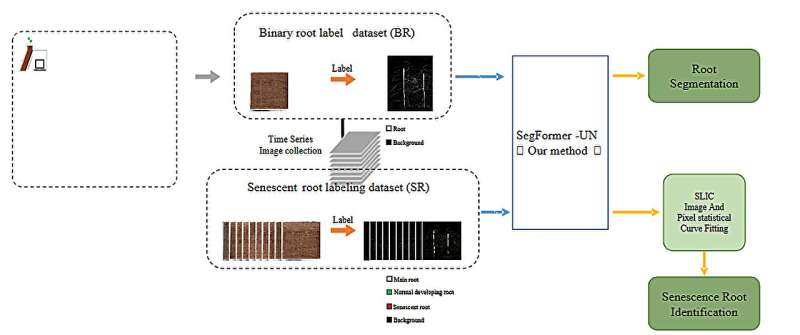This article has been reviewed according to Science X's editorial process and policies. Editors have highlighted the following attributes while ensuring the content's credibility:
fact-checked
trusted source
proofread
Improving root senescence recognition with a new semantic segmentation model

Roots play a vital role in plant health, adapting to environmental changes and indicating crop growth. However, studying root senescence is challenging due to difficulties in obtaining clear in situ root images. Traditional methods are limited, and while in situ cultivation and advanced imaging techniques offer some solutions, they face issues such as high costs and low image quality. Recent advances in deep learning, particularly semantic segmentation models like SegNet and UNet, have improved root identification but still require further optimization.
In March 2024, Plant Phenomics published a research article titled "Improved Transformer for Time Series Senescence Root Recognition." This study focuses on utilizing the RhizoPot system and exploring root segmentation models to enhance root senescence recognition, aiming to fill the gap in efficient, accurate root analysis for better plant health monitoring.
This paper evaluates eight segmentation models, including PSPNet, SegNet, UNet, DeeplabV3plus, TransUNet, SwinUNet, SETR, and a novel approach which is named SegFormer-UN trained uniformly for 100 epochs. The SegFormer-UN model, particularly its "Small" version, demonstrates superior performance with higher mIoU and mRecall rates of 81.06% and 86.29%, respectively, while maintaining lower computational demands (FLOPs and Params).
Further, a "Large" version of SegFormer-UN even outperforms this with the highest recorded mIoU, mRecall, and mF1 scores. This indicates a clear advancement over traditional methods and other TransFormer neural networks, despite the deeper model requiring more computational resources.
In-depth analysis through ablation studies reveals that altering the upsampling method alone diminishes performance metrics compared to the base model, highlighting the complexity of optimizing segmentation accuracy. However, modifications in the decoder structure, specifically adopting the UNet and DeeplabV3plus decoders, show varied results. SegFormer-UN stands out by significantly enhancing the accuracy and reducing computational load, proving the effectiveness of integrating advanced decoders with the model's architecture.
Furthermore, the paper explores root senescence extraction, demonstrating the SegFormer-UN model's ability, which can accurately classify and extract senescent roots rapidly, leveraging GPU acceleration. This method significantly outperforms traditional image processing techniques, reducing processing time from 31 minutes to about 4 minutes per image, and provides more precise root system identification despite challenges with occlusion by soil particles.
Additionally, time-series analysis of root senescence, utilizing dimensionality reduction and clustering, indicates an increase in senescence proportion over time, validated by high R-Squared values from polynomial fitting.
In conclusion, the SegFormer-UN model, particularly its application to root segmentation and senescence extraction, exhibits a significant advancement in accuracy, efficiency, and computational economy. This study not only sets a new benchmark for root segmentation models but also emphasizes the potential for deep learning techniques in agricultural research, particularly in understanding root systems and their senescence patterns.
More information: Hui Tang et al, Improved Transformer for Time Series Senescence Root Recognition, Plant Phenomics (2024). DOI: 10.34133/plantphenomics.0159
Provided by NanJing Agricultural University





















